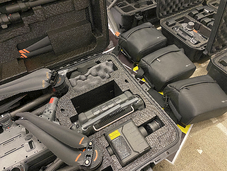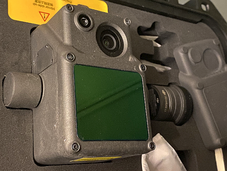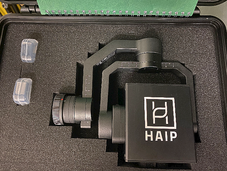Drohnen in der Vulkanologie: Verbesserung von Forschung und Sicherheit



Drohnen sind in der Vulkanologie unverzichtbar, da sie den sicheren Zugang zu aktiven Vulkanen ermöglichen und Echtzeitdaten liefern. Mit Kameras, Wärmesensoren und Gasanalysatoren erfassen sie wichtige Informationen, die bei der Vorhersage von Ausbrüchen helfen. Hochauflösende Luftbilder und topografische Karten unterstützen die Analyse vulkanischer Geomorphologie und Lavaströme. Dank kosteneffizienter und schneller Einsatzfähigkeit sowie fortschrittlicher Sensorik (z. B. Lidar, thermisches Infrarot) verbessern sie die Datenerfassung und Modellierung vulkanischer Prozesse, während ihr nicht-invasiver Ansatz die Umwelt schont. Die gewonnenen Daten finden zudem interdisziplinäre Anwendungen – aktuell werden Drohnen auch für seismische Stationen entwickelt.
Drohnen sind unverzichtbar für die sichere und effiziente Erforschung von Vulkanen.
Vorteile der Drohnennutzung:
- Zugang zu gefährlichen Gebieten: Sie erreichen aktive Vulkane, die für Forscher unzugänglich sind, und liefern Daten aus Kratern und Risikozonen.
- Echtzeitüberwachung: Ausgestattet mit Kameras, Wärmesensoren und Gasanalysatoren erfassen sie Gasemissionen, thermische Anomalien und Landschaftsveränderungen.
- Hochauflösende Kartierung: Drohnen erstellen präzise topografische Karten zur Analyse von Lavaströmen und Eruptionsfolgen.
- Kosteneffizient: Günstiger als bemannte Flüge oder Satellitenbilder, ermöglichen sie langfristige Überwachung.
- Schneller Einsatz: Ideal für Notfallhilfe und Evakuierungsplanung.
- Fortschrittliche Datenerfassung: Sensoren wie Lidar und Infrarot liefern detaillierte Einblicke in vulkanische Prozesse.
- Umweltschonend: Sie haben einen minimalen ökologischen Fußabdruck.
- Interdisziplinäre Anwendungen: Daten sind wertvoll für Geologie, Atmosphärenforschung und Umweltwissenschaft. Derzeit entwickeln wir Drohnen für seismische Stationen.
Walter, Thomas (2024): Drone based photogrammetry data at the Geysir geothermal field, Iceland. GFZ Data Services. https://doi.org/10.5880/GFZ.2.1.2024.001
Lun, A., Walter, T., Aguilera, F., Layana, S., Mania, R., Kujawa, C., Zimmer, M., Inostroza, M. (2023): Crater morphology, nested ring structures, and temperature anomalies studied by unoccupied aircraft system data at Lascar volcano, northern Chile. - Journal of Volcanology and Geothermal Research, 439, 107840. https://doi.org/10.1016/j.jvolgeores.2023.107840.
Marzban, P., S. Bredemeyer, T.R. Walter, F. Kaestner, D. Mueller, and S. Chabrillat, 2023, Hydrothermally altered deposits of 2014 Askja landslide, Iceland, identified by remote sensing imaging. Frontiers in Earth Science. 11. https://doi.org/10.3389/feart.2023.1083043.
Allahbakhshi, M.; Shevchenko, A.V.; Belousov, A.B.; Belousova, M.G.; Kämpf, H.; Walter, T.R. Geothermal Explosion at the 2014 Landslide-Covered Area of the Geyser Valley, Kamchatka, Russian Far East. GeoHazards 2023, 4, 60-76. https://doi.org/10.3390/geohazards4010005.
Darmawan, H., Putra, R., Budi-Santoso, A., Humaida, H., Walter, T. (2023): Morphology and Instability of the Merapi Lava Dome Monitored by Unoccupied Aircraft Systems. - In: Gertisser, R., Troll, V. R., Walter, T., Nandaka, I. G. M. A., Ratdomopurbo, A. (Eds.), Merapi Volcano: Geology, Eruptive Activity, and Monitoring of a High-Risk Volcano, (Active Volcanoes of the World), Cham: Springer International Publishing, 457-472. https://doi.org/10.1007/978-3-031-15040-1_15.
Mueller, D., T.R. Walter, M. Zimmer, and G. Gonzalez, 2022, Distribution, structural and hydrological control of the hot springs and geysers of El Tatio, Chile, revealed by optical and thermal infrared drone surveying. Journal of Volcanology and Geothermal Research. 432. https://doi.org/10.1016/j.jvolgeores.2022.107696.
Darmawan, H., V.R. Troll, T.R. Walter, F.M. Deegan, H. Geiger, M.J. Heap, N. Seraphine, C. Harris, H. Humaida, and D. Muller, 2022, Hidden mechanical weaknesses within lava domes provided by buried high-porosity hydrothermal alteration zones. Nature Scientific Reports. 12(1). https://doi.org/10.1038/s41598-022-06765-9.
Bindeman, I.N., F.M. Deegan, V.R. Troll, T. Thordarson, A. Hoskuldsson, W.M. Moreland, E.U. Zorn, A.V. Shevchenko, and T.R. Walter, 2022, Diverse mantle components with invariant oxygen isotopes in the 2021 Fagradalsfjall eruption, Iceland. Nature Communications. 13(1). https://doi.org/10.1038/s41467-022-31348-7.
Shevchenko, A.V., V.N. Dvigalo, E.U. Zorn, M.S. Vassileva, F. Massimetti, T.R. Walter, I.Y. Svirid, S.A. Chirkov, A.Y. Ozerov, V.A. Tsvetkov, and I.A. Borisov, 2021, Constructive and Destructive Processes During the 2018-2019 Eruption Episode at Shiveluch Volcano, Kamchatka, Studied From Satellite and Aerial Data. Frontiers in Earth Science. 9. https://doi.org/10.3389/feart.2021.680051.
Mueller, D., S. Bredemeyer, E. Zorn, E. De Paolo, and T.R. Walter, 2021, Surveying fumarole sites and hydrothermal alteration by unoccupied aircraft systems (UAS) at the La Fossa cone, Vulcano Island (Italy). Journal of Volcanology and Geothermal Research. 413. https://doi.org/10.1016/j.jvolgeores.2021.107208.
Zorn, E.U., T.R. Walter, J.B. Johnson, and R. Mania, 2020, UAS-based tracking of the Santiaguito Lava Dome, Guatemala. Scientific Reports. 10(1). https://doi.org/10.1038/s41598-020-65386-2.
Walter, T.R., P. Jousset, M. Allahbakhshi, T. Witt, M.T. Gudmundsson, and G.P. Hersir, 2020, Underwater and drone based photogrammetry reveals structural control at Geysir geothermal field in Iceland. Journal of Volcanology and Geothermal Research. 391. https://doi.org/10.1016/j.jvolgeores.2018.01.010.
Walter, T.R., A. Belousov, M. Belousova, T. Kotenko, and A. Auer, 2020, The 2019 Eruption Dynamics and Morphology at Ebeko Volcano Monitored by Unoccupied Aircraft Systems (UAS) and Field Stations. Remote Sensing. 12(12). https://doi.org/10.3390/rs12121961.
James, M., Carr, B., D'Arcy, F., Diefenbach, A., Dietterich, H., Fornaciai, A., Lev, E., Liu, E., Pieri, D., Rodgers, M., Smets, B., Terada, A., von Aulock, F., Walter, T., Wood, K., Zorn, E. (2020): Volcanological applications of unoccupied aircraft systems (UAS): Developments, strategies, and future challenges. - Volcanica, 3, 1, 67-114. https://doi.org/10.30909/vol.03.01.67114.
Gaete, A., T.R. Walter, S. Bredemeyer, M. Zimmer, C. Kujawa, L.F. Marin, J. San Martin, and C.B. Parra, 2020, Processes culminating in the 2015 phreatic explosion at Lascar volcano, Chile, evidenced by multiparametric data. Natural Hazards and Earth System Sciences. 20(2): p. 377-397. https://doi.org/10.5194/nhess-20-377-2020.
Walter, T.R., J. Salzer, N. Varley, C. Navarro, R. Arambula-Mendoza, and D. Vargas-Bracamontes, 2018, Localized and distributed erosion triggered by the 2015 Hurricane Patricia investigated by repeated drone surveys and time lapse cameras at Volcan de Colima, Mexico. Geomorphology. 319: p. 186-198. https://doi.org/10.1016/j.geomorph.2018.07.020.
Darmawan, H., T.R. Walter, K.S. Brotopuspito, Subandriyo, and I.G.M.A. Nandaka, 2018, Morphological and structural changes at the Merapi lava dome monitored in 2012-15 using unmanned aerial vehicles (UAVs). Journal of Volcanology and Geothermal Research. 349: p. 256-267. https://doi.org/10.1016/j.jvolgeores.2017.11.006.
Muller, D., T.R. Walter, A. Schopa, T. Witt, B. Steinke, M.T. Gudmundsson, and T. Durig, 2017, High-Resolution Digital Elevation Modeling from TLS and UAV Campaign Reveals Structural Complexity at the 2014/2015 Holuhraun Eruption Site, Iceland. Frontiers in Earth Science. 5. https://doi.org/10.3389/feart.2017.00059.
(for publications older than this please refer to the GFZ section 2.1 publication page)